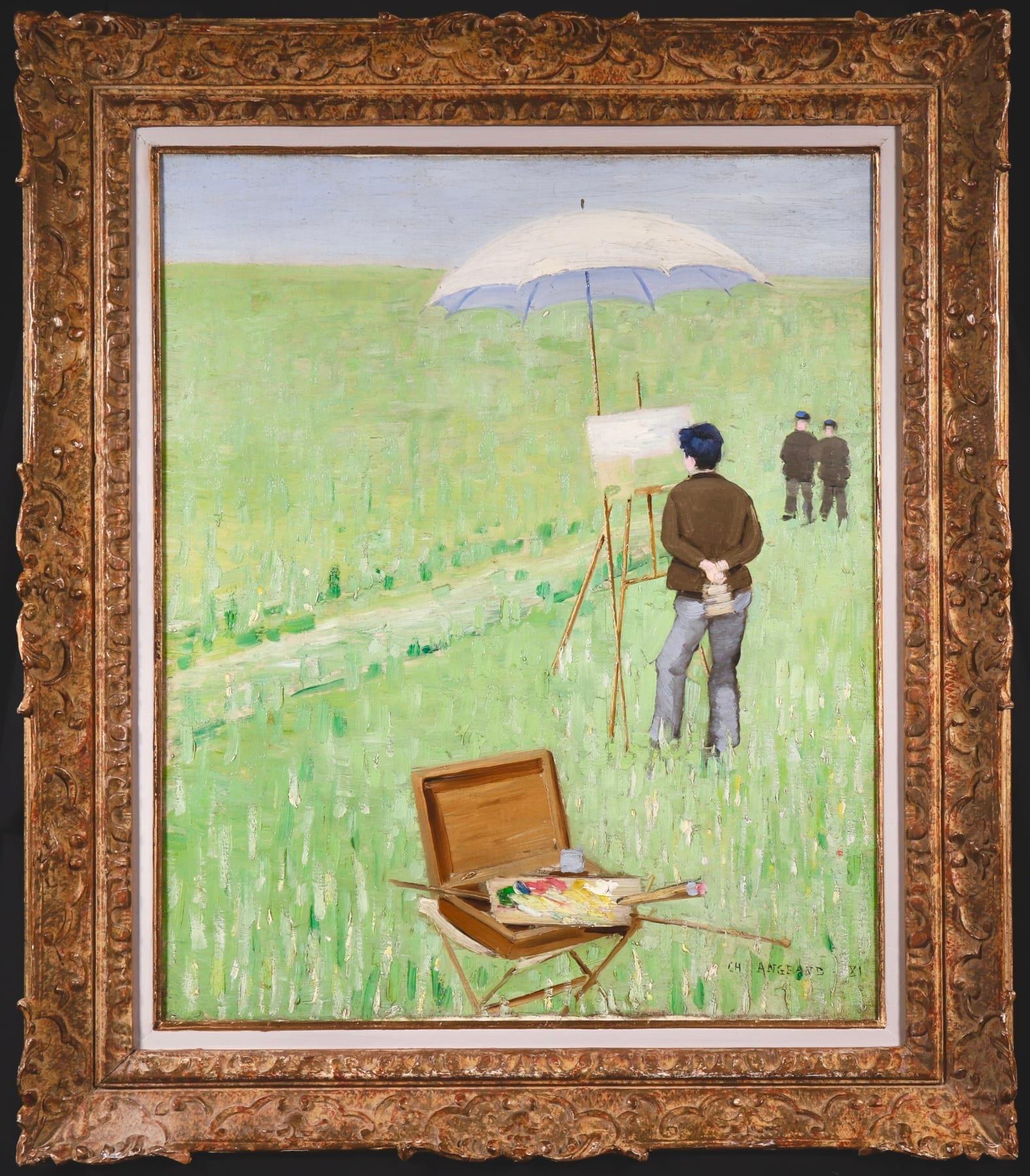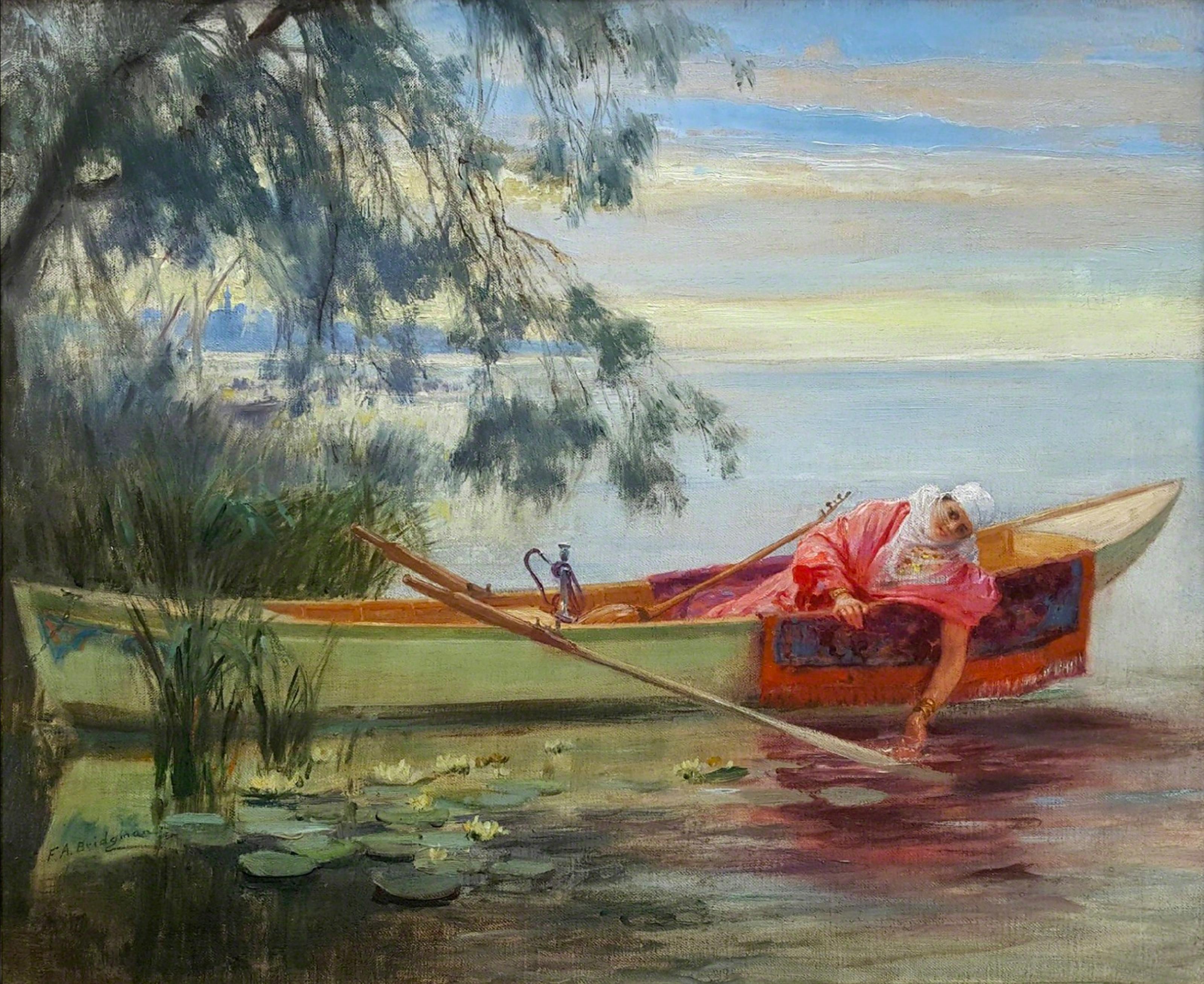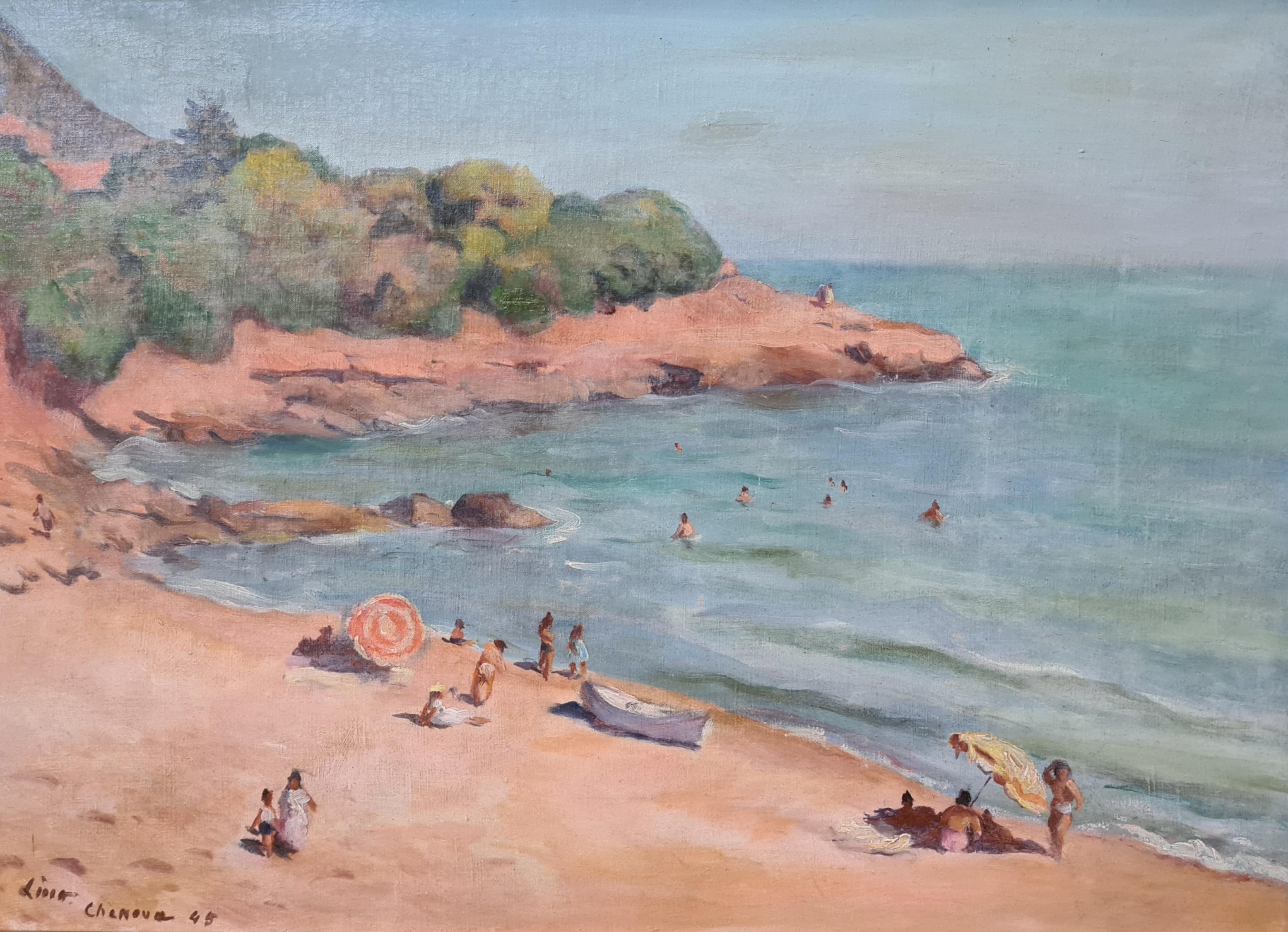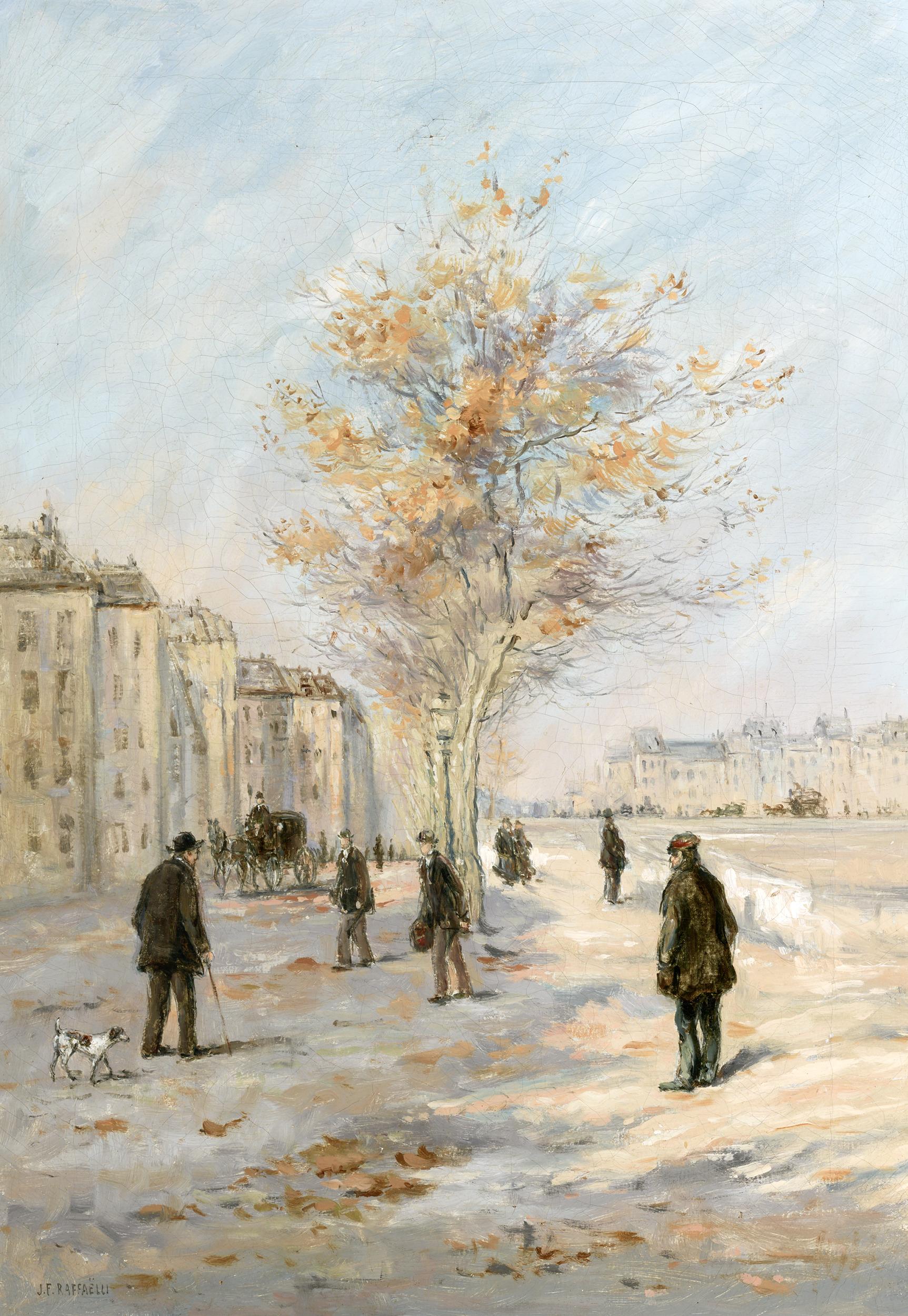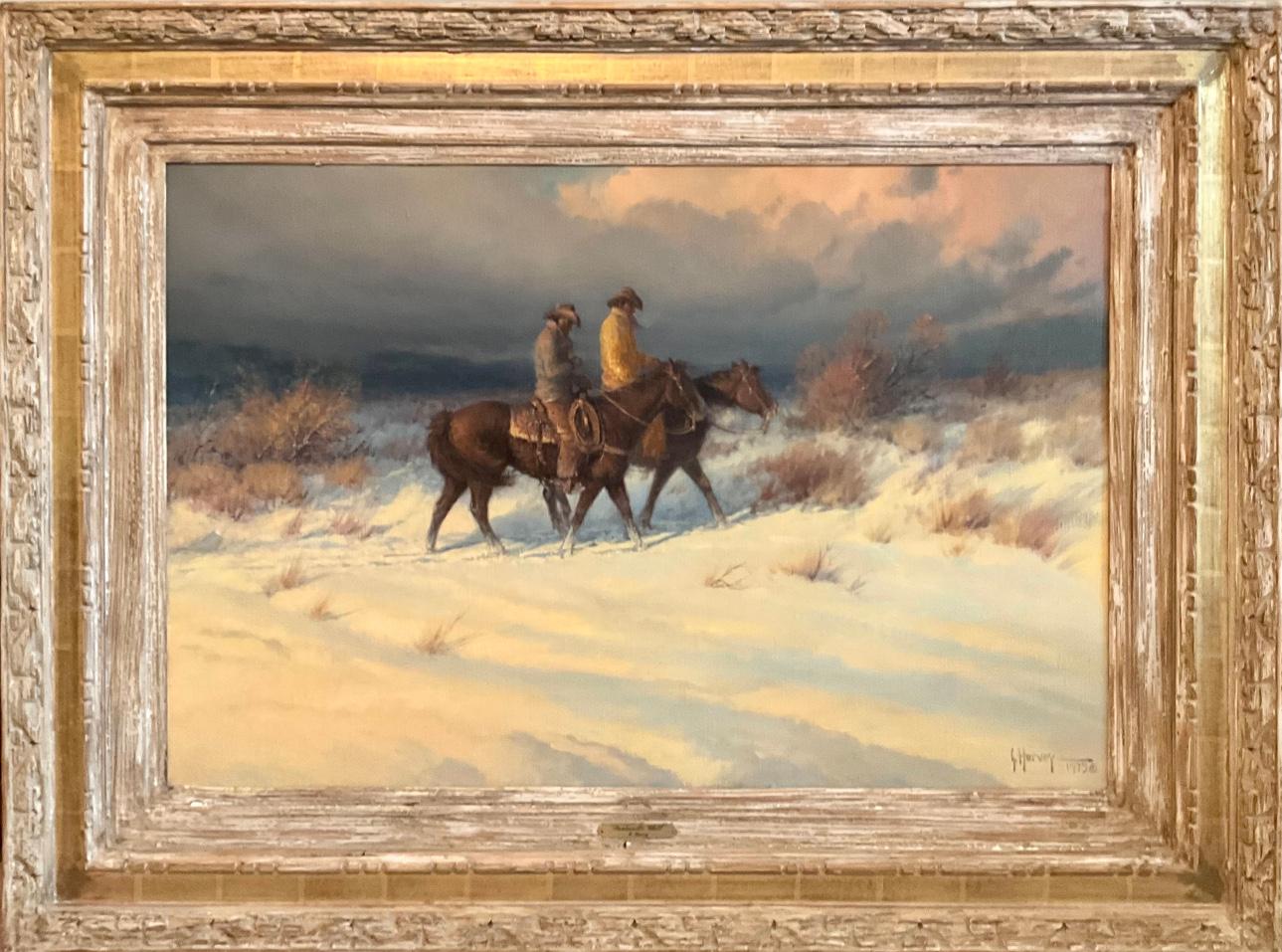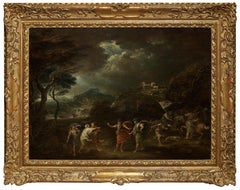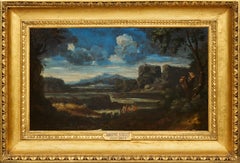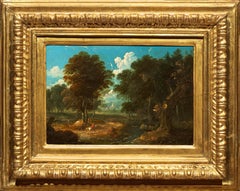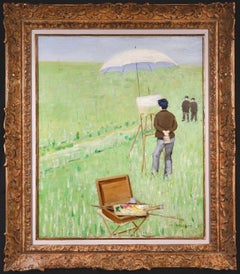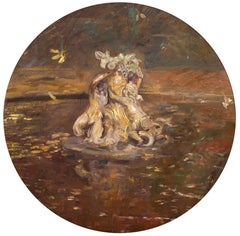
Autumn in Versailles - painting by Paul César Helleu an Impressionist Painter
View Similar Items
Want more images or videos?
Request additional images or videos from the seller
1 of 8
Paul César HelleuAutumn in Versailles - painting by Paul César Helleu an Impressionist PainterCirca 1894
Circa 1894
About the Item
- Creator:Paul César Helleu (1859-1927, French)
- Creation Year:Circa 1894
- Dimensions:Height: 33.66 in (85.5 cm)Diameter: 33.66 in (85.5 cm)
- Medium:
- Movement & Style:
- Period:
- Condition:Signed "Helleu" at the bottom left. It appears in the ‘catalogue raisonné’ under the reference HU3-1128. Provenance: Gaston Palewski Louis XVI giltwood frame : 42.13 "diameter (107 cm) This painting has been restored - CR available upon request.
- Gallery Location:PARIS, FR
- Reference Number:1stDibs: LU156828205942
Paul César Helleu
Rich impression with dramatic drypoint burr and tone no other artist epitomizes the whole atmosphere of elegance and hedonistic pleasure which pervaded Paris society at the first decade of the century as does Helleu. A close friend of Proust and the inspiration for one of the principal characters in La Recherche du Temps Perdu, Helleu’s whole life style echoed the incomparable elegance and flow of his drawing, the sheer style of his art, and his eye for the poses of the beautiful women who were his friends and his patrons. During the 1870’s, Helleu had come to know the painters of Impressionism and also artists Sargent and Whistler who became his special friends and inspiration. By the early 1880’s, he had already developed the quality of expressive sweeping line, which is the essence of his drawing, but in 1885 he was encouraged by Tissot to try working on prints in drypoint. At this time, Tissot had decided, after the death of his lover and model Kathleen Newton, to travel to the Holy Land on an artistic pilgrimage. Having decided he would no longer engrave, he gave Helleu his diamond stylus…a literal and figurative “passing of the baton”. It was in the incision and texture of drypoint that his art was to reach one of its greatest peaks. He had an innate feel for the balance between a lightly curving stroke and the deeply cut highly tonal burr of the strongest drypoint. Around the turn of the century he started to combine drypoint with multi-inking in colors, the areas of color restricted to such touches as the bows on the hats, the hair color or the red of the lips. The plate was drawn at a single sitting, and then the color inks were brushed onto it. The results are some of the most splendid and decorative of all Belle Époque prints.
About the Seller
5.0
Vetted Seller
These experienced sellers undergo a comprehensive evaluation by our team of in-house experts.
Established in 2020
1stDibs seller since 2021
8 sales on 1stDibs
Typical response time: 2 hours
More From This SellerView All
- Macbeth and the Three Witches a Painting on Panel by Francesco ZuccarelliBy Francesco ZuccarelliLocated in PARIS, FRThis painting, created during Zuccarelli's stay in England, represents the decisive moment when Macbeth, together with Banquo, meets the three witches who announce that he will be Ki...Category
1760s Old Masters Landscape Paintings
MaterialsOil, Wood Panel
- Italian Landscape with Jack Players, a painting by Gaspard Dughet (1615 - 1675)By Gaspard DughetLocated in PARIS, FRHere Gaspard Dughet offers us an idyllic vision of the Roman countryside. The stages follow one another in a perfectly structured composition, revealing here a lake, there travellers walking along, gradually leading our eye to the blue horizon. But behind its classical composition, this landscape is particularly interesting because of three anthropomorphic details that the artist has hidden, opening the way to a radically different interpretation... 1. Gaspard Dughet, a landscape artist in the light of Poussin Gaspard Dughet was born on June 4th, 1615 in Rome where his father, of French origin, was a pastry cook. He was probably named Gaspard in honour of his godfather Baron Gaspard de Morant, who was, or may have been, his father's employer. His older sister Jeanne married the painter Nicolas Poussin (1594 - 1655) on September 1st, 1630. The young Gaspard was apprenticed with his brother-in-law at the beginning of 1631, which led his entourage to name him Gaspard Poussin. The first preserved works of the painter date from the years 1633-1634 and were painted in Poussin’s studio. Around 1635, Gaspard Dughet became emancipated and began to frequent the Bamboccianti circle. In 1636, he became friends with the painter Jean Miel (1599 - 1656), but also with Pier Francesco Mola (1612 - 1666) and Pietro da Cortona (1596 - 1669). This was also the time of his first trips throughout Italy. The painter, although of French origin, appears never to have visited France. In 1646 he settled permanently in Rome. A recognized painter with a solid book of orders, he remained faithful to landscape painting throughout his life, alternating between cabinet paintings and large decorative commissions, using both oil and fresco. Nailed to his bed by rheumatic fever at the age of 58, he died on May 25, 1675. 2. Discovering an idealized landscape Beyond a relatively dark foreground that takes us into the landscape, we discover a vast bluish horizon: a plateau surrounded by deep ravines advances to the right, overhanging an expanse of water that sparkles below. A road winds through a mountainous mass as if leading us to the fortress that crowns it; another town appears in the distance at the foot of three conical mountains. The composition is rigorous, mineral, and structured by geometric volumes. The various stages in the landscape lead one to the next attracting the eye towards the horizon located in the middle of the canvas. The general impression is that of a welcoming and serene nature. In many places the paint layer has shrunk, or become transparent, revealing the dark red preparation with which the canvas was covered and accentuating the contrasts. Human presence is limited to three jack players, leaning against a mound in the foreground. Their long garments, which may evoke Roman togas, contribute to the timelessness of the scene. Close examination of the canvas reveals two other travellers on the path winding between the rocks. Made tiny by the distance, their introduction in the middle register, typical of Dughet's art, lengthens the perspective. While it is difficult to date the work of a painter who devoted his entire life to the representation of landscapes, it is certain that this painting is a work from his later years. The trees that occupied the foreground of his youthful compositions have been relegated to the sides, a stretch of water separates us from the arid mountains counterbalanced by two trees represented on the opposite bank. The introduction of this stretch of water in the middle of the landscape betrays the influence of the Bolognese and in particular of the Dominiquin (1581 - 1641) A number of similarities with a drawing in the British Museum might suggest a date around 1656-1657, since, according to Marie-Nicole Boisclair , it has been compared with the Prado's Landscape with the Repentant Magdalene, painted at that period. 3. Three amazing anthropomorphic details While some late Renaissance landscapes offer a radical double reading, allowing one to see both a face or a human body behind the representation of a landscape, it seems interesting to us to hypothesize that Gaspard Dughet had fun here by slipping in a few details that, taken in isolation, evoke human or animal figures. We will give three examples, looking closely at a cloud, the trunk of a broken tree and the top of a cliff. The main cloud could thus evoke a Christ-like face or that of an antique god...Category
1650s Old Masters Landscape Paintings
MaterialsOil
- Stag Hunting in the Vicinity of Nuremberg by a German Artist Peter von BemmelLocated in PARIS, FRThis small landscape shows a hunting scene: two riders are chasing a stag with their dogs at the edge of a forest. Signed by Peter von Bemmel, it is typical of the production of this...Category
1720s Old Masters Landscape Paintings
MaterialsCopper
- The Parade of Swiss Guards a painting on canvas by Gabriel de Saint-AubinLocated in PARIS, FRIn this painting, Gabriel de Saint-Aubin, the great chronicler of the reign of Louis XV, takes us to the annual parade of the Swiss Guards at the Plaine de...Category
1760s Old Masters Figurative Paintings
MaterialsCanvas, Oil
- Virgin and Child, a paiting by David Teniers the Younger after Palma VecchioBy David Teniers the YoungerLocated in PARIS, FRProvenance: Dukes of Marlborough Collection, Blenheim Palace until its sale at Christie's London on 26 July 1886 (lot 172) English private collection until its sale at Christie's London on 11 December 1992 (lot 363) Erna Weidinger Collection (1923 - 2021) - Austria Literature : Georg Scharf - A list of the pictures in Blenheim Palace - Catalogue raisonné Part 2 - London 1862 (page 166 - number 199 "after Palma Giovane") Charles Davies...Category
1750s Old Masters Figurative Paintings
MaterialsOak, Oil
- Portrait of Jean-Baptiste Greuze, painted on linen by his daughter Anna GreuzeLocated in PARIS, FRThis replica of the last self-portrait of Jean-Baptiste Greuze painted in 1804, executed by his daughter Anna at her father's side and recently rediscovered, provides us with a poignant image of the great artist, represented with panache despite the disillusions of life. 1. Jean-Baptiste Greuze Jean-Baptiste Greuze was the sixth child of a roofer from Tournus and retained a certain rusticity in his behaviour from his provincial childhood, beyond his taste for describing picturesque scenes of the countryside. He initially started training with a little-known painter from Lyon, Charles Grandon, before his genius was recognised in Paris where he became a full-time student of the Académie (of Painting) in 1755. He exhibited his work for the first time at the Salon during the summer of 1755, before leaving on a trip to Italy in the company of Louis Gougenot, abbot of Chezal-Benoît. Upon his return to Paris, Greuze became a prolific painter, participating widely in the Salons held between 1759 and 1765, to which he sent no less than 63 paintings: numerous genre scenes (The Marriage Contract, The Beloved Mother), but also portraits of his family circle, of courtiers and art lovers, or of his colleagues. The Academy closed the doors of the Salons to him in 1767 for not having produced his reception piece within six months of his reception, as was the tradition. He worked actively on this painting (Emperor Severus rebukes Caracalla, his son, for trying to assassinate him ) until the summer of 1769, tackling historical and mythological subjects for the first time. Once this was completed, he was then fully admitted to the Academy, but as a genre painter, and not as an historical painter, which had been one of the greatest humiliations of his life. Greuze then refused any participation in events organised by the Academy or its successor, the Academy of Fine Arts until 1800. Abandoning history painting, he gave a new twist to genre scenes, bringing them closer to history painting, as in this pair of canvases which constitutes some of his masterpieces: The Paternal Curse: The Ungrateful Son and The Paternal Curse: The Punished Son . Married in 1759 to Anne-Gabrielle Babuti, the daughter of a Parisian bookseller, his marriage was unhappy and his wife probably frequently unfaithful. The institution of divorce enabled him to record their separation in 1793, keeping his two daughters Anna-Geneviève, born in April 1762, and Louise-Gabrielle, born in May 1764, with him. Little is known about his daughter Anna except that she was herself a painter and lived with her father until his death. It is likely that most of the paintings she produced up to that date were attributed to her father, whose technique she shared to a great extent, making it extremely difficult to establish an autonomous corpus of her paintings. Greuze died in his studio at the Louvre on March 21st 1805. The attention paid to the expressivity of his characters and the emotional charge they convey enabled Jean-Baptiste Greuze to enjoy immense popularity with the eighteenth-century public, and they still constitute Greuze's true modernity. As the artist said, "I dipped my brush in my heart". Greuze was also an exceptional draughtsman and a portraitist of immense talent and exceptional longevity who painted both the Dauphin (the son of Louis XV and father to Louis XVI) and the young Napoleon Bonaparte. 2. Greuze's self-portraits Greuze was very much influenced by Dutch paintings during all his life. While the source of his inspiration for genre scenes can be found in Gerard Dou...Category
Early 1800s Old Masters Portrait Paintings
MaterialsLinen, Oil
You May Also Like
- 'Agay, le château et le Sémaphore'. Oil on canvas. Signed.By Armand GuillauminLocated in Paris, FR'Agay, le château et le Sémaphore'. Oil on canvas. +/- 1922 Signed lower right Measurements : 60 x 73 cm. This painting will be recorded in the second volume of the Catalogue Raisonn...Category
1920s Impressionist Landscape Paintings
MaterialsOil
- Painting en plein air - Impressionist Figure in Landscape Oil by Charles AngrandBy Charles AngrandLocated in Marlow, BuckinghamshireSigned and dated oil on canvas by French impressionist painter Charles Theophile Angrand. This wonderful and good-sized piece depicts an artist painting "en plain air" in a beautiful...Category
1880s Impressionist Figurative Paintings
MaterialsCanvas, Oil
- Signed Antique French Impressionist Oil Painting Children Playing in ParkBy Louis Abel-TruchetLocated in Cirencester, GloucestershireIn the Park by Louis Abel-Truchet (French 1857-1918) *see below signed oil on canvas, unframed canvas: 16 x 13 inches provenance: private collection, France condition: overall good a...Category
Late 19th Century Impressionist Landscape Paintings
MaterialsCanvas, Oil
- Sur le Bosphone, On the Bosphorus, Orientalist Beautiful Girl in BoatBy Frederick Arthur BridgmanLocated in Miami, FLThe key to this painting's charm is that the subject is a beautiful young woman who is showing her face. We see her with her charming smile. She lounges comfortably in a carpeted bo...Category
1980s Impressionist Landscape Paintings
MaterialsOil
- "Le Dompteur de Pigeons" (ex. Christie's) - Large Antique Impressionist PaintingBy Georges Jules Victor ClairinLocated in New Orleans, LAA large, spectacular, absolutely splendid painting by noted French painter Georges Clairin, which appeared for auction at Christie's in 2004 (see photo...Category
Late 19th Century Impressionist Landscape Paintings
MaterialsOil
- Coastal Scene of the French RivieraLocated in San Francisco, CAThis artwork titled "Paysage de la cote d'azur (Coastal Scene of the French Riviera)" c.1960, is an oil painting on canvas by French artist Rene Dulieu, 1903-1992. It is signed at the lower left corner by the artist. The canvas size is 21.5 x 25.85 inches, framed size is 35 x 39 inches. Custom framed in original dark brown and gold distressed frame, with fabric liner and gold color fillet. It is in excellent condition, the frame have minor restorations, practically invisible. About the artist. Self-taught painter of figurative painting. At eleven years old, it was the Great War and his Certificate of Studies in his pocket, he first worked in the fields of the village farms, then until he was 17, he was employed at the Coeuvres distillery where he is responsible for the proper functioning of the machines. In 1925 he did his military service at the barracks of St Vincent de Laon (Aisne) in the 101st heavy artillery regiment as a pointer brigadier, and he was already drawing on notebooks. At the end of his service, having chosen to go to Paris to take drawing and painting lessons, he became a cashier at the Grand Magasins du Louvre. He begins to discover Paris, its districts, its buildings, shops, churches. During the week he sets up his easel on the sidewalks of Montmartre, Notre Dame, where the Latin Quarter and on Sundays, he sells these paintings on Boulevard Raspail. He took part in the Battle of France in September 1939at june 1940. He testifies in a notebook of the events and emotions he has gone through. After the Second World War, he set up his home and studio in the 15th arrondissement of Paris, but he remained very attached to his native village where he went very regularly. Married, he takes his family almost every summer to the Côte d'Azur where he paints with great pleasure the warm colors and the intense light of the Esterel or the Var coast. He participates in many Parisian salons and exhibitions in Paris and province. Awarded at the Salon des Artistes Indépendants in 1961, as well as at the Salon Violet in Paris. From 1967, Mrs. Rosenthal of the Galerie Haussmann (Paris), regularly exhibited her works on "Old Paris" which particularly appealed to British and American tourists. He participated with the painters René Demeurisse...Category
Mid-20th Century Impressionist Landscape Paintings
MaterialsOil
Recently Viewed
View AllMore Ways To Browse
Tissot Mother Of Pearl
Wooden Rosary Beads
Pearl Basin
Antique Whistle Necklace
Antique Rosary Beads Rosaries
Antique Rosary Necklace
Blanche Hoschede
Blanche Hoschede Monet
Rosary Large Beads
Gustave Singer
Fountain Petite
Edouard Du Temps
Wooden Bead Necklace
Outdoor Garden Fountain Water
Antique Rosary Beads
Golden Whistle
Monet Glass Necklace
Jean Monnet
